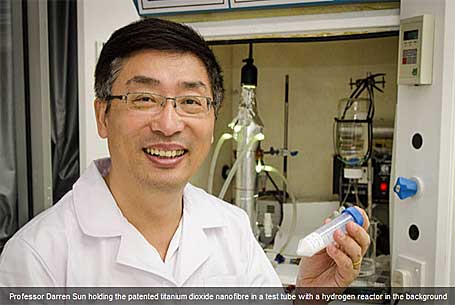
The silver bullet in hydrogen production may actually be made out of titanium dioxide. At least this is what Associate Professor Darren Sun at Nanyang Technological University (NTU) is saying.
Under the category of the “Best Thing Since Sliced Bread and Ginsu Knives” Professor Sun has invented the Multi-use Titanium Dioxide (TiO2). When combined with nanofiber materials TiO2 can split water, create hydrogen, purify and desalinate water, recover energy from wastewater, generate electricity, double the life of a lithium ion battery and even be made into antibacterial bandages.
Titanium dioxide is abundant and cheap so no precious metals need to be used for all of the previously mentioned applications. It took the Professor five years to develop this material and over 70 scientific papers have been written about his invention.
According to NTU.edu, “This discovery, which was published recently in the academic journal, Water Research, showed that a small amount of nanomaterial (0.5 grams of titanium dioxide nanofibres treated with copper oxide), can generate 1.53 millilitre of hydrogen in an hour when immersed in one litre of wastewater. This amount of hydrogen produced is three times more than when Platinum is used in the same situation. Depending on the type of wastewater, the amount of hydrogen generated can be as much as 200 millilitres in an hour. Also to increase hydrogen production, more nanomaterial can be used in larger amounts of wastewater.”
Professor Sun is part of a team of 20 researchers who believe so much in the Multi-use Titanium Dioxide material that they are spinning off a startup company in order to commercialize the material. They are now looking for business partners to help speed up the commercialization process. Perhaps a visit to the TV show “Shark Tank” will now be in order.
great dr sorell doing something similar nsw university sydney. yes water resistant yes just what is needed yes competion ,may the best product version win. yes no platium pem cells and then alternate yes liquid carriers.and methane produced, yes cheaper than 1.5 a gallon yes usa.yes 30,000 dollars new hydrogen cars, luxury 50,000. yes 30 t0 20,000. other versions of a car any..clean and zero and zero green.methane carrier to.. yes.capture carbon to materials…100.percent sustainable.total usa energy reliance and yes grerat savings, a gallon.yes cheaper stations infrastructure. yes iron and other catylists.
Titanium dioxide, isn’t that used as an altervative material for making solar collectors? Think cheap solar panels by laying down wire and then painting over them with a Titanium dioxide paint. There is a lot of warehouse roof space.
TiO2 makes toothpaste white. So titanium dioxide is cheap.
Even if titanium dioxide based solar panels are inefficient, they make up for that by being cheap.
Don’t think it should be surprising that Titanium Dioxide is useful for producing hydrogen when the compound is useful for so many things.
I hope the technique for producing hydrogen using titanium dioxide as a catalyst is commercialized and soon. This is one more piece in the puzzle
of why produce vehicles that use hydrogen? There has to be a plentiful source of hydrogen for those vehicles. Lower the cost of the fuel cells in FCEVs as well, all the ingredients for widespread usage of hydrogen fueled vehicles come into place.
The real news is that commercialization efforts are being made and the product will be inexpensive enough to make an impact.
Hydrogen is a very light gas. Has anyone worked out the rate of loss of that gas to outer space or it’s effect on the upper atmosphere should we have a hydrogen fuel economy? Of course, I am thinking of long term effects but technologies have been developed which later are seen to have great drawbacks – coal burning being just one of these dangerous technologies.
Hello David, I’m no chemist, but my understanding of hydrogen is in two points. First, hydrogen is the most abundant element in the universe. Second, hydrogen tends to bond quickly with other elements and compounds. In a fuel cell, hydrogen gas and oxygen from the air travel around the membranes creating a electrical charge and finally coming together to form heat and water (or steam).
Here’s the Wikipedia take on hydrogen: http://en.wikipedia.org/wiki/Hydrogen
Here’s more information on my website: https://www.hydrogencarsnow.com/hydrogen-atoms.htm
We are developing a hydrogen delivery system that will be portable and on demand for a new eco friendly diesel.
we need to increase the volume of pure orthohydogen gas before we can delivery amounts needed to operate this engine at various rpms. Our concept is not a hybrid, but 100% hydrogen delivery unit. We would like to know how Multi-use Titanium Dioxide (TiO2– could be used to benefit our project. Our sister company that is going to mfg. the new diesel would like to talk to your group regarding a possible joint venture. please reply/
i want to know how i can produce using silver or silica coated silver